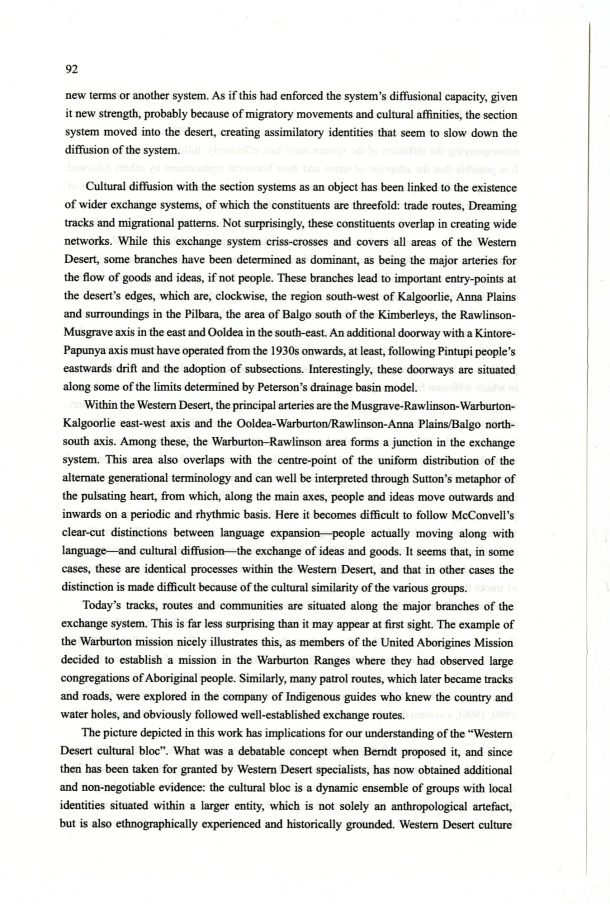|
| 
[Note: this transcription was produced by an automatic OCR engine]
92
new terms or another system. As if this had enforced the system’s difiusional capacity, given
it new strength, probably because of migratory movements and cultural aflinities, the section
system moved into the desert, creating assimilatory identities that seem to slow down the
diffusion of the system.
Cultural ditfusion with the section systems as an object has been linked to the existence
of wider exchange systems, of which the constituents are threefold: trade routes, Dreaming
tracks and migrational patterns. Not surprisingly, these constituents overlap in creating wide
networks. While this exchange system criss-crosses and covers all areas of the Western
Desert, some branches have been determined as dominant, as being the major a.rteries for
the flow of goods and ideas, if not people. These branches lead to important entry-points at
the desert’s edges, which are, clockwise, the region south-west of Kalgoorlie, Anna Plains
and surroundings in the Pilbara, the area of Balgo south of the Kimberleys, the Rawlinson-
Musgrave axis in the east and Ooldea in the south-east. An additional doorway with a Kintore-
Papunya axis must have operated from the 1930s onwards, at least, following Pintupi people’s
eastwards drifi and the adoption of subsections. Interestingly, these doorways are situated
along some of the limits determined by Peterson’s drainage basin model.
Within the Western Desert, the principal arteries are the Musg;rave-Rawlinson-Warburton-
Kalgoorlie east-west axis and the Ooldea-Warburton/Rawlinson-Anna Plains/Balgo north-
south axis. Among these, the Wa.rburton—Rawlinson area forms a junction in the exchange
system. This area also overlaps with the centre-point of the uniform distribunon of the
alternate generational terminology and can well be interpreted through Sutton’s metaphor of
the pulsating heart, from which, along the main axes, people and ideas move outwards and
inwards on a periodic and rhythmic basis. Here it becomes ditficult to follow McConvell’s
clear-cut distinctions between language expansion—people actually moving along with
language—and cultural difiusion—the exchange of ideas and goods. It seems that, in some
cases, these are identical processes within the Western Desert, and that in other cases the
distinction is made diflicult because of the cultural similarity of the various groups.
Today’s tracks, routes and communities are situated along the major branches of the
exchange system. This is far less surprising than it may appear at first sight. The example of
the Warburton mission nicely illustrates this, as members of the United Aborigines Mission
decided to establish a mission in the Warburton Ranges where they had observed large
congregations of Aboriginal people. Similarly, many patrol routes, which later became tracks
and roads, were explored in the company of Indigenous guides who knew the country and
water holes, and obviously followed well-established exchange routes.
The picture depicted in this work has implications for our understanding of the “Westem
Desert cultural bloc”. What was a debatable concept when Berndt proposed it, and since
then has been taken for granted by Western Desert specialists, has now obtained additional
and non-negotiable evidence: the cultural bloc is a dynamic ensemble of groups with local
identities situated within a larger entity, which is not solely an anthropological artefact,
but is also et.hnog:raphica.lly experienced and historically grounded. Western Desert culture
|